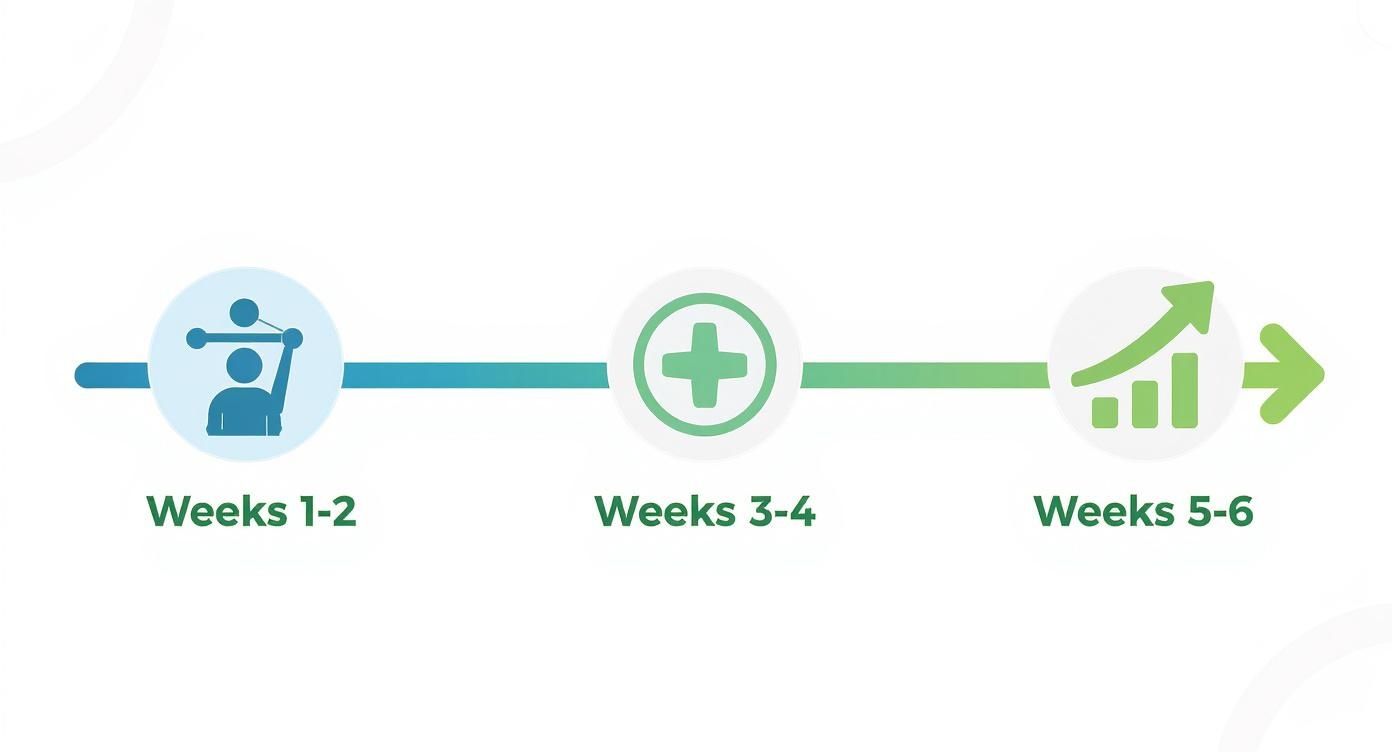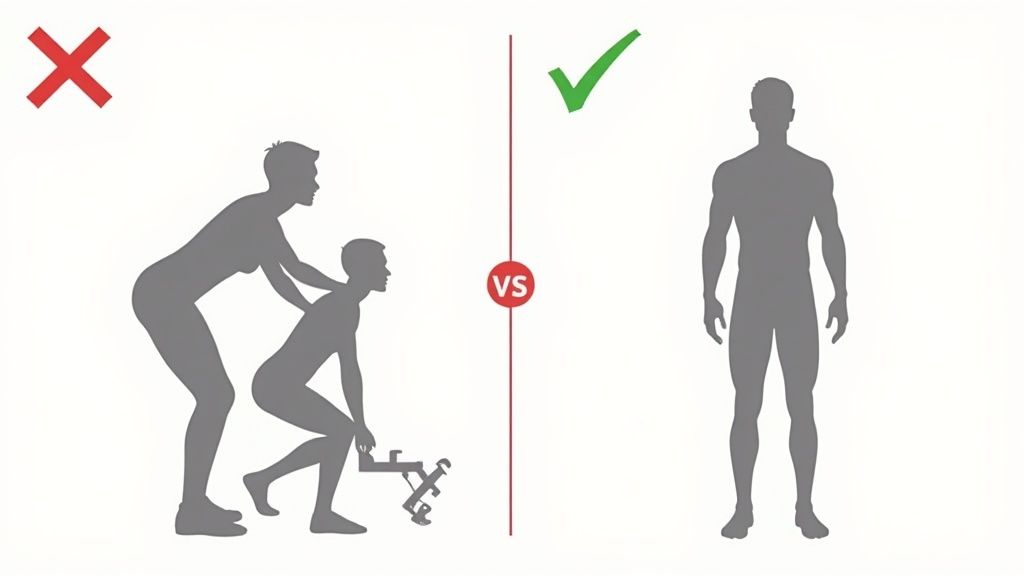If you've ever felt stuck in your workout routine, you're not alone. You show up, put in the work, but the results just aren't coming like they used to. The missing ingredient is almost always the same: progressive overload.
This might sound like a complicated gym term, but it's the simple, non-negotiable rule for getting stronger and fitter. In short, it means you have to consistently make your workouts just a little bit harder over time. That’s it. That's the secret to turning your effort into real, lasting results.
This guide will walk you through exactly what progressive overload is and how you can use it at home with minimal equipment to break through plateaus and finally see the progress you deserve.
The Simple Idea Behind All Fitness Progress

Our bodies are incredibly smart. They're masters of adaptation. When you first start a new exercise, it feels tough because it's a new challenge. But after a few weeks of doing the same thing—the same exercises, the same reps, the same routine—your body adapts. It gets efficient. The challenge disappears, and so does your progress.
Think of it like learning a new skill. At first, just learning a few chords on a guitar is a huge win. But you wouldn't just play those same three chords forever and expect to become a rockstar. You'd move on to more complex songs, a faster tempo, or a new technique. Your fitness journey works exactly the same way.
The core principle of progressive overload is giving your body a compelling reason to change. By systematically increasing the demand you place on your muscles, you're sending a clear signal: "Hey, we need to get stronger to handle this."
Why Small, Consistent Steps Win
This isn't about going from zero to hero overnight or pushing yourself to exhaustion in every single session. That's a recipe for burnout, not progress. The real magic happens with small, smart, and sustainable increases.
Maybe this week you do 8 push-ups instead of 7. Maybe next week you hold your plank for 5 seconds longer. These tiny steps forward are what build unstoppable momentum over the long haul.
This idea is as old as strength itself. It's often traced back to the ancient Greek legend of Milo of Croton, a famous wrestler. The story goes that he built his incredible strength by lifting a newborn calf every single day. As the calf grew into a full-grown bull, so did Milo’s strength. He was applying progressive overload without even knowing it. You can dive deeper into the history and science behind this principle to see just how foundational it is.
Milo’s ancient training plan gives us a perfect blueprint for our own fitness:
- Start with what you can handle: Don't try to lift the bull on day one. Start with the calf.
- Be consistent: Show up and do the work regularly.
- Increase the challenge gradually: As your capacity grows, slowly increase the demand.
Progressive overload is the essential ingredient that turns effort into results. Without it, you’re just maintaining your current fitness level, not improving it. It ensures every workout builds on the last, creating a clear path to your goals.
Why This Principle Is Your Key to Real Results
Ever feel like you’re just spinning your wheels with your workouts? You show up, you put in the work, but the results you were hoping for just aren’t showing up. It's a common frustration, and it almost always means your body has adapted to your current routine.
Our bodies are incredibly efficient. Once they get used to a certain challenge—like doing the same 10 bodyweight squats every week—they stop seeing any reason to change or grow stronger. This is exactly why understanding what is progressive overload becomes your secret weapon for finally breaking through that plateau.
Your Body Needs a Reason to Change
Think of your first workout as an alarm bell going off for your muscles. They were forced to respond to a new, unfamiliar stress. But if you keep ringing that same quiet bell over and over, they eventually learn to sleep right through it. To get their attention again, you have to ring it a little louder.
That's the core idea here. You have to continuously and strategically challenge your muscles to stimulate growth. This process, known as muscle hypertrophy, only kicks in when you ask your body to do just a little bit more than it's comfortable with.
Progressive overload isn’t just about lifting heavier; it’s the fundamental language you use to tell your body, “It’s time to get stronger, build more endurance, and become more capable.”
This single principle is what transforms your consistent effort into actual, visible results. It ensures your fitness journey is always moving forward, not just stuck in a holding pattern.
The Benefits Go Beyond Muscle
Applying progressive overload does more than just make you stronger. It's a game-changer for your entire fitness experience.
- Boosting Endurance: Consistently pushing your limits teaches your body to use oxygen and energy more efficiently. Before you know it, you can work out for longer without feeling gassed.
- Keeping Workouts Engaging: Let's face it, doing the exact same routine forever is boring. Introducing new challenges keeps your mind just as engaged as your body.
- Building Lasting Habits: Seeing real progress is the ultimate motivator. When you can physically feel yourself getting stronger week after week, you're far more likely to stick with it for the long haul.
Without this key principle, you're essentially just maintaining your current fitness level. By learning how to apply it, you take direct control of your progress and make sure every single drop of sweat actually counts.
How to Use Progressive Overload at Home (No Gym Required)
Think you need a gym membership and a rack of heavy weights to see real results? Think again. The very same principles of what is progressive overload that build muscle in the gym can be put to work right in your living room.
At Bare Fitness, our whole philosophy is built on making fitness work for you, wherever you are. You don't need fancy equipment to challenge your body. Let's break down exactly how you can apply progressive overload at home and turn basic exercises into powerful catalysts for change.
What You'll Need
- Your own bodyweight
- A comfortable space to move
- (Optional) A resistance band or a stable chair for modifications
5 Simple Ways to Progress Your Home Workouts
1. Increase Your Repetitions (Reps)
This is the most intuitive place to start. If you managed eight good squats last week, your mission this week is to aim for nine or ten. Simple as that. The goal is to nudge the number up by one or two reps per set while keeping your form sharp. That tiny increase is a direct message to your muscles: "Hey, we need to get stronger for this!"
2. Add More Sets
Okay, so you've hit a point where you're comfortably knocking out, say, 12-15 push-ups per set. Instead of just chasing more and more reps, try adding a whole new set to your workout. If you were doing three sets of 12 push-ups, the next step is to tackle four sets of 12. This approach seriously bumps up your total training volume—the overall work your muscles are doing—without grinding you into the ground on any single set.
3. Decrease Your Rest Time
Want to crank up the intensity without adding a single rep or set? Start watching the clock. If you typically rest for a full 60 seconds between sets of lunges, try trimming that down to just 45 seconds next time. By shortening your recovery window, you’re forcing your muscles to get back to work before they're fully ready. This not only improves your muscular endurance but also makes your workouts way more efficient.
4. Increase Time Under Tension (Slow It Down)
Sometimes, the secret to making an exercise harder isn't doing more, but doing it slower. Instead of powering through your squats, try deliberately slowing down the entire movement. For instance, take a full three seconds to lower yourself into the squat, pause for a beat at the bottom, then take another three seconds to stand back up. This is known as increasing your time under tension (TUT), and it keeps your muscles firing for much longer in each rep. Trust me, 10 super-slow reps will feel worlds harder than 10 rushed ones.
The secret to long-term success is making small, sustainable changes. Don’t try to do everything at once. Pick one method, apply it for a few weeks, and once that feels manageable, introduce a new challenge.
For anyone just starting out, slow and steady truly wins the race. In fact, research points to a low-intensity progression—something like increasing your reps or volume by about 2% every two weeks—as a sweet spot. It provides a gradual but powerful signal for your body to adapt, all while keeping the risk of injury low. This thoughtful approach helps you build both strength and endurance in a balanced way. You can learn more about how to unlock your gains with smart progression.
5. Make the Exercise More Difficult (Progression)
Finally, one of the best parts of bodyweight training is leveling up the exercises themselves. Once you master one version, you can move on to a more difficult variation.
Here are a few classic examples of this in action:
- From Kneeling Push-ups to Full Push-ups: Start by building strength on your knees, then graduate to doing them on your toes.
- From Glute Bridges to Single-Leg Glute Bridges: After you’re rock-solid with two-legged bridges, you can really challenge your glutes and core with the single-leg version.
- From Plank to Plank with Leg Lifts: A standard plank is a great foundation, but lifting one leg at a time introduces a major core stability challenge.
This method does more than just build strength; it keeps your workouts engaging and helps you develop new skills along the way.
Applying Progressive Overload to Common Exercises
As you can see, progression isn't about one single path. You can mix and match these methods—adding reps one month, changing the exercise the next—to keep your body guessing and growing stronger over time.
Your Simple 4-Week Progression Plan
Knowing the theory behind progressive overload is great, but seeing it in action is what really makes it click. Let's put it all together with a straightforward, four-week plan that takes the guesswork out of getting stronger. We’ll use three simple bodyweight exercises to build a solid foundation.
Think of this as your starting line, not a race to the finish. It’s all about creating momentum and proving to yourself that you can make real progress, right from your own home.

The Workout and Your Weekly Mission
The workout itself couldn't be simpler. You’ll do it three times a week on non-consecutive days—think Monday, Wednesday, and Friday—to give your body ample time to recover and rebuild.
Your Core Exercises:
- Bodyweight Squats
- Push-ups (on your knees or toes—pick the version that's challenging but allows you to maintain great form)
- Glute Bridges
Now, let's look at how you'll level up each week.
Week 1 Focus: Master Your Form
This week is all about quality over quantity. Your mission isn’t to exhaust yourself; it’s to make every single repetition perfect.
- Workout: 3 sets of 8-10 reps for each exercise.
- Rest: 60-90 seconds between each set.
- How to do it: Concentrate on the mind-muscle connection. Feel your glutes and quads firing during the squat. Feel your chest working on the push-up. This foundation is non-negotiable.
Week 2 Focus: Increase Repetitions
Now that your form is solid, it's time to ask your muscles to do just a little more work. This is one of the easiest ways to start applying progressive overload.
- Workout: 3 sets of 10-12 reps for each exercise.
- Rest: 60-90 seconds between sets.
- How to do it: Your goal is to add 2 reps to every set you did last week. If the last set feels a bit too easy at 12, go for 13 or 14—just don't let your form get sloppy.
Remember, the goal is to make it just a little bit harder than last time. A small step forward is still a huge win and is the essence of effective progressive overload.
Week 3 Focus: Add a Set
This week, we're increasing the total volume of your workout. Adding a whole extra set is a pretty big jump in the amount of work your muscles have to do.
- Workout: 4 sets of 10-12 reps for each exercise.
- Rest: 60-90 seconds between sets.
- How to do it: You're doing a fourth round of everything. That last set will feel tough, but that's a good thing! It’s exactly the kind of challenge your body needs to adapt and grow stronger.
Week 4 Focus: Decrease Rest Time
Time to turn up the intensity. By shortening your rest periods, you force your body to recover faster between sets, which is fantastic for building muscular endurance.
- Workout: 4 sets of 10-12 reps for each exercise.
- Rest: Only 45-60 seconds between sets.
- How to do it: Be strict with your rest. Use a timer on your phone. You'll notice your heart rate stays up throughout the workout—a clear sign that you're pushing your conditioning.
How to Track Your Progress and Stay Motivated
Applying progressive overload is one thing, but actually seeing your hard work pay off? That’s what keeps you coming back for more. Motivation runs on progress, and the only way to see progress is to track it.
Don't worry, you don't need a fancy app or a complicated spreadsheet. A simple notebook and pen or even the notes app on your phone will do the trick. This little logbook is about to become your most powerful motivational tool.
What to Write Down
Keep it simple. For each workout, just jot down these key details:
- Exercises: What movements did you do?
- Sets and Reps: How many sets and reps for each? (e.g., Squats: 3 sets of 10 reps).
- Rest Periods: How long did you rest between sets?
- How It Felt: A quick note like "Felt strong" or "Last rep was a real grind" adds crucial context.
This isn't just a diary; it's the blueprint for your next session. It takes the guesswork out of the equation and tells you exactly what you need to beat to keep the gains coming.
The goal of tracking isn't about perfection; it's about consistency. Your workout journal is tangible proof that all your effort is adding up, turning small, daily steps into huge long-term results.
Without this constant, incremental challenge, your body hits a wall. It adapts, and your progress grinds to a halt. In fact, studies show that muscle adaptation can plateau in as little as 4 to 6 weeks without a structured plan. Those small, planned increases are everything.
Celebrate More Than Just the Numbers
Progress isn't always measured in reps or sets. Some of the best wins happen outside your workout entirely. These are your "non-scale victories," and they’re powerful reminders that what you're doing is actually changing your life.
Start paying attention to moments like:
- Having more energy to get through your workday.
- Hauling all the groceries inside in one trip, no problem.
- Holding a plank for 10 seconds longer than you could a month ago.
- Catching your reflection and noticing your posture has improved.
When you start recognizing these real-world improvements, you build a deeper, more sustainable kind of motivation that will keep you in the game for the long haul.
Common Mistakes to Avoid When Starting

Starting a progressive overload plan is exciting. That initial burst of motivation is powerful, but it's easy to get carried away and stumble into a few common pitfalls. Knowing what to look out for will help you build strength safely and turn that early enthusiasm into a long-lasting habit.
The biggest trap? Trying to do way too much, way too soon. You crush a workout, feel amazing, and immediately decide to double the reps next time. While the ambition is great, that kind of leap is a classic recipe for burnout or injury, killing your progress before it truly begins.
Sacrificing Form for More Reps
When you’re laser-focused on hitting a new personal record, it’s tempting to let your form get a little sloppy just to eke out that last rep. This is a critical error. Bad form doesn't just cheat you out of the exercise's true benefits; it puts you at risk for injury. Always remember that one perfect rep is infinitely better than five sloppy ones. Quality of movement must always come first.
The goal of progressive overload isn't just about doing more; it's about doing more well. Master the movement, then add the challenge. This is how you build a strong, resilient body.
This is where balancing volume and intensity comes in. Some complex training philosophies can get so fixated on one method that they create an imbalance. For example, some old-school ideas from sources like Westside Barbell can be overly complex for beginners and may not fit a minimal-equipment approach, highlighting the need for a smart, simple strategy that works for you.
Ignoring the Importance of Rest
Here’s a secret that’s not really a secret: your muscles don't get stronger during your workout. They get stronger while you rest. The stress of training creates tiny micro-tears in your muscle fibers, and it's during recovery that your body repairs them, building them back even stronger than before. Skipping rest days or skimping on sleep completely undermines this whole process.
- Listen to your body: If you're feeling unusually sore, run-down, or weak, that’s a clear signal you might need an extra day off. Pushing through is not the answer.
- Prioritize sleep: Aim for a solid 7-9 hours of quality sleep each night. This is when your body does most of its repair work.
- Try active recovery: On your off days, light activities like a brisk walk, gentle yoga, or stretching can do wonders for soothing sore muscles and keeping blood flowing.
Your Progressive Overload Questions Answered
Jumping into a new training concept always brings up a few questions. That's a good thing—it means you're thinking critically about how to make it work for you. Let's clear up some of the most common ones about progressive overload.
How Often Should I Increase the Challenge?
There's no single, magic answer here. A good rule of thumb is to aim for a small, manageable increase every week or two. The real key is consistency, not how fast you progress.
The most important signal is your own body. You should only think about adding reps or sets when you can complete all of your current sets with solid form. If you felt strong and the last set was challenging but doable, you're probably ready to push a little harder next time. If you were really struggling, it's smart to repeat that same workout until it feels more controlled.
Is This Only for Bodybuilders?
Not even close! Progressive overload is a fundamental principle for anyone who wants to get stronger, fitter, or more capable in their daily life. It’s the core engine of all physical improvement.
Think about it this way. The principle applies whether your goal is to:
- Carry all the groceries in one trip without struggling
- Keep up with your kids at the park without getting winded
- Boost your endurance for your weekend runs
- Simply feel more confident and capable in your own skin
This concept is what gets you from where you are to where you want to be.
What if I Can’t Add Another Rep or Set?
Hitting a plateau is completely normal. In fact, it's an inevitable part of getting stronger. The trick is not to just keep ramming against that wall. Instead, it's time to get a little creative.
The goal is to challenge the muscle, not just chase numbers. If you can't do more, find a way to make the work you're already doing harder.
When you feel stuck, try switching up your method of overload:
- Slow it Down: Perform each repetition with a much slower, more deliberate tempo.
- Cut Your Rest: Shave 10-15 seconds off your rest periods between sets.
- Perfect Your Form: Go deeper in your squat or focus on a full range of motion in your push-up. Making the movement better is a form of progress.
Sometimes, the smartest move is actually to take a step back. A planned "deload week" where you go easier can give your body the recovery it needs to smash through that plateau when you come back.
Next Steps
Now that you understand what progressive overload is, you have the most important tool for building a stronger, healthier body. You don't need a gym or complicated equipment—just a plan and the consistency to follow it.
Ready to stop guessing and start seeing real, measurable progress? The workouts at Bare Fitness are built to help you put these principles into practice simply and effectively, right from home. Find your next favorite workout at Bare Fitness.




















